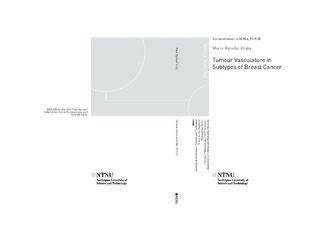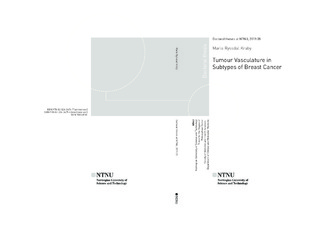| dc.description.abstract | Breast cancer is a group of heterogeneous diseases. Using immunohistochemistry (IHC) and in situ hybridisation (ISH), they can be separated into molecular subtypes with distinct biology and prognosis. The Luminal A subtype has the best prognosis. It is positive for hormone receptors and has little potential for growth and proliferation. Patients with the hormone receptor negative subtypes, the non-luminal, have the poorest prognosis. Nonluminal subtypes are further classified into three groups, depending on their expression of a set of biomarkers (HER2 type, basal phenotype (BP), five-negative phenotype (5NP)). By studying the breast tumour, the Breast Cancer Subtypes (BCS) project aims to increase our understanding of the tumour biology, and to identify prognostic factors, in each molecular subtype. This dissertation is a result of three papers (two are published, one is presented as a manuscript). The work is based on a series of 909 women from Trøndelag county, diagnosed with breast from 1961 to 2008, and followed from the time of diagnosis to 2010. Tumours from these women were previously reclassified into molecular subtypes with IHC and ISH.
Access to the vascular network is a prerequisite for tumour growth and metastasis. Angiogenesis, the sprouting of capillaries from existing vessels, is the most well-known mechanism for tumour cells to gain access to blood vessels, where nearby capillaries are stimulated to proliferation and infiltration into the tumour tissue. Microvessel density (MVD) describes the number of vessels in the most vessel-rich tumour region, called the vascular hotspot. MVD is the most commonly used method for vasculature quantification in tumour tissue. However, there are great methodological variations in MVD assessment between studies. This thesis studied three methods for quantifying the vasculature in breast cancer tumour tissue; MVD, described as the average number of vessels/mm2 in the vascular hotspot; proliferating MVD (pMVD), which is the average number of proliferating vessels measured in the same way as MVD; and vascular proliferation index (VPI) is the ratio of pMVD to MVD.
In the first study, we compared BP and Luminal A, which are the most biologically distinct subtypes. BP tumours had higher pMVD and VPI than Luminal A, but the point estimate was low. Increased MVD was associated with poor prognosis in all cases combined. However, when separated according to subtype, MVD was a prognostic factor only in the Luminal A.
The Luminal A tumours in this study represent a more aggressive subset than Luminal A tumours as a whole, so these results should be validated in a more representative selection of Luminal A tumours.
In the second study, we considered MVD, pMVD and VPI in all the non-luminal subtypes. MVD was higher in 5NP tumours compared to both HER2 type and BP. Increasing MVD was associated with poor prognosis in all cases combined, but in analyses of each subtype separately, MVD only provided prognostic information in HER2 type and 5NP. This could imply that MVD is a prognostic factor in some subtypes, but not in others. pMVD and VPI were not associated with prognosis in either of the studies. Our results should be confirmed in a larger sample size.
In the third study, we investigated which field area used for MVD assessment that provided the most accurate prognostic information. All cases from the two previous studies were included. Prognostic information became less accurate when a larger field area was included, and the most accurate prognostic information was obtained by including the two visual field with the highest number of vessels only.
The results of these studies provide novel information about tumour biology for individual subtypes of breast cancer. They also provide information about prognostic factors in breast cancer, and imply that each subtype may have a different set of prognostic factors. By demonstrating that MVD provided the most accurate prognostic information when using a smaller field area with only the most vessel-dense visual fields, our results could contribute to a more efficient and standardised method for assessment of MVD in breast cancer. | |
| dc.relation.haspart | Paper 1: Kraby, Maria Ryssdal; Krüger, Kristi; Opdahl, Signe; Vatten, Lars Johan; Akslen, Lars A.; Bofin, Anna M.. Microvascular proliferation in luminal A and basal-like breast cancer subtypes. Journal of Clinical Pathology 2015 ;Volum 68.(11) s. 891-897
http://dx.doi.org/10.1136/jclinpath-2015-203037 | nb_NO |

